Hotels in Vietnam are quite affordable and offer great value for money. This time, we stayed at the Citadines Regency Saigon, with an average price of $60 per night. The location is fantastic—right at the border between District 1 and District 3. It’s about a 10-minute walk to the Central Post Office and about 15 minutes to the Pink Church. Just a few steps from the hotel, you’ll find two convenience stores, GS25 and Circle K, as well as several ATMs and a bus stop. The convenience of daily life in the area is excellent!
The hotel’s exterior has a French-style design, with small railings on each room’s window, adding to the charm. From the window, you can enjoy a skyline view of the city center. The service at the hotel was also impressive. We arrived at around 1 or 2 a.m. on the first day, and I noticed a small black spot on the bedsheet. After calling the front desk, the staff immediately came and enthusiastically changed it for us, taking great care. The two security guards outside the hotel always greeted us with smiles, which added to the overall great service.
The hotel was generally clean, and the facilities were complete. One thing to note is that some rooms have a door connecting to the neighboring room, which is normally locked. However, if you’re traveling with a group, it can be opened. If this is something you’re concerned about, it’s worth keeping in mind. The hotel also has a rooftop pool, but we didn’t have time to check it out during our stay.


Regarding the itinerary:
Departure – Ho Chi Minh City
Book Street – Central Post Office – Pho Viet Nam – Independence Palace – City Hall – Opera House – Man Moi – City Sightseeing Bus
Vung Tau Day Trip: Front Beach – Jesus Mountain – Back Beach
Mui Ne Day Trip: Fairy Stream – Fishing Village – Coastal Road – White Sand Dunes – Red Sand Dunes
Little Hanoi Egg Coffee – Ho Chi Minh City Fine Arts Museum – Ben Thanh Market – Pink Church – Landmark 81
Ho Chi Minh City – Return Journey
The tourist spots in Ho Chi Minh City are relatively concentrated, with attractions close to each other, so walking between them isn’t too far. For other times, you can opt for ride-hailing services or taxis. You can use Grab for ride-hailing, and I noticed that taxis here are generally good, safe, and comfortable. They also respond quickly to bookings—usually within one or two minutes. Even during late-night hours, it’s easy to find a taxi without worrying about availability.



In the early morning, Ho Chi Minh City’s streets are already flooded with a sea of motorbikes. Every few steps, you’ll find a coffee shop, most of which serve coffee right at the entrance with a few plastic stools, creating a lively and down-to-earth atmosphere. Everywhere you look, you’ll see apartment buildings with colorful shutters, and the balconies are often lined with brightly colored clothes drying in the sun. The vibrant colors always brighten my mood.


Right across the street from the side of the Pink Church is Book Street. As the name suggests, it’s a street lined with bookstores and creative cultural products. The street is relatively narrow, with small stalls or exhibits set up in the middle. The best part is that it’s pedestrian-only, making it a comfortable and relaxing place to stroll and browse.


On Book Street, there are many stalls offering portrait sketches, each artist with their own unique style. I chose one with a more cute and playful art style. It took about ten minutes to complete a sketch, and it only cost 50,000 VND. Keeping a portrait as a memento is really a wonderful idea!



Right next to Book Street is the Central Post Office, built in the late 19th century. The exterior still retains its colonial-style architecture, with grand arches and a towering clock, making it stand out in the modern cityscape. You’ll often see students sketching on the sidewalk outside. Once inside, you can browse through various sizes and designs of postcards at the central counter. After purchasing your postcards, you can head to the long writing table at the back to fill them out.
It’s a good idea to bring your own pen, as it can be hard to find one if the place is busy. When addressing the postcard, make sure to clearly write both the postal code and the address. It’s best to include both your local language and English on the address for clarity. Once your postcard is written, head to the counters on either side to buy stamps. They’ll ask which country you’re sending it to, as the number of stamps required varies by region. After affixing the stamps, simply drop your postcard into the nearby basket.








A sudden downpour disrupted our plans for the next stop. The rain in Ho Chi Minh City truly comes without warning—one moment it’s dry, and the next, the sky opens up. Everyone rushed into the post office for shelter, though a few brave souls ventured out into the rain. Once the rain lightened up a bit, I took a taxi to a famous pho restaurant called Pho Viet Nam, a Michelin-recommended spot.
The restaurant has two storefronts just about ten meters apart. After we got out of the car, a staff member kindly escorted us to the entrance under a large umbrella. I ordered two of their recommended dishes: the stone pot beef pho and their signature Vietnamese beef pho.
The stone pot beef pho, priced at 100,000 VND, is served with raw beef that you dip into the hot stone pot to cook. The portion was generous, and the meat was incredibly tender. The broth was rich, and the overall flavor was perfect.
The signature Vietnamese beef pho, priced at 80,000 VND, was also a hearty portion filled with various ingredients. The broth was lighter compared to the stone pot version, but still had a rich, authentic beef flavor, and the beef was equally tender.
The staff first brought out a plate of bean sprouts and green herbs. The proper way to eat it is to pick off the tender leaves and add them to your bowl, rather than tossing in the entire stem.
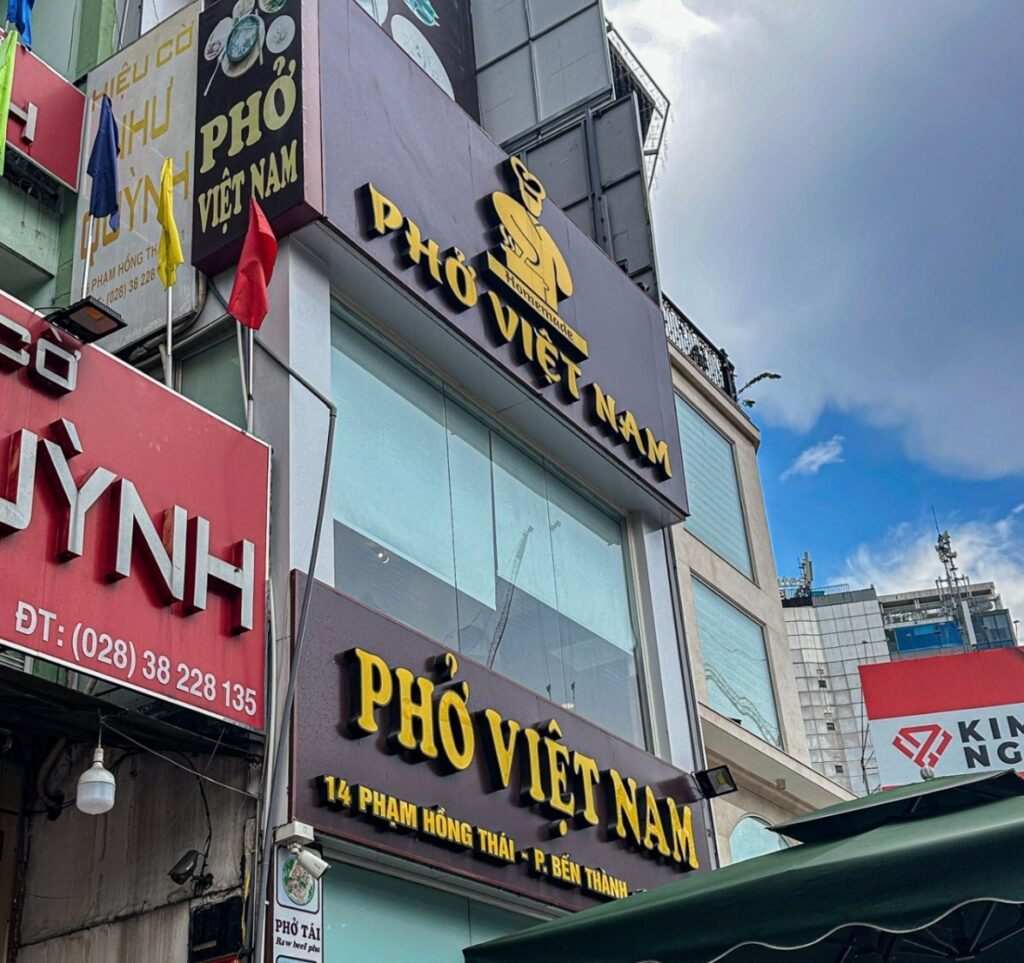



The Independence Palace, located in the heart of Ho Chi Minh City, was originally built by the French colonialists to strengthen their control over Vietnam. Construction began on February 23, 1869, under the supervision of the governor of Southern Vietnam at the time, covering an area of 20,000 square meters. The project took three years to complete.
In 1954, after the French withdrew, the “Norodom Palace” was handed over to the Vietnamese government. To symbolize Vietnam’s newfound independence from French colonial rule, the government renamed it the “Independence Palace.” Later, with the reunification of North and South Vietnam, it was renamed the “Reunification Palace,” becoming a symbol of the Vietnamese people’s struggle for national independence and unity.
To visit the Reunification Palace, you need to purchase a ticket at the entrance, which costs 65,000 VND. Inside, there are various meeting rooms and offices, but since we didn’t have a deep understanding of Vietnamese history, we only took a quick tour around. The exhibition halls inside don’t have air conditioning, and only a few spots had small fans, making it quite hot.





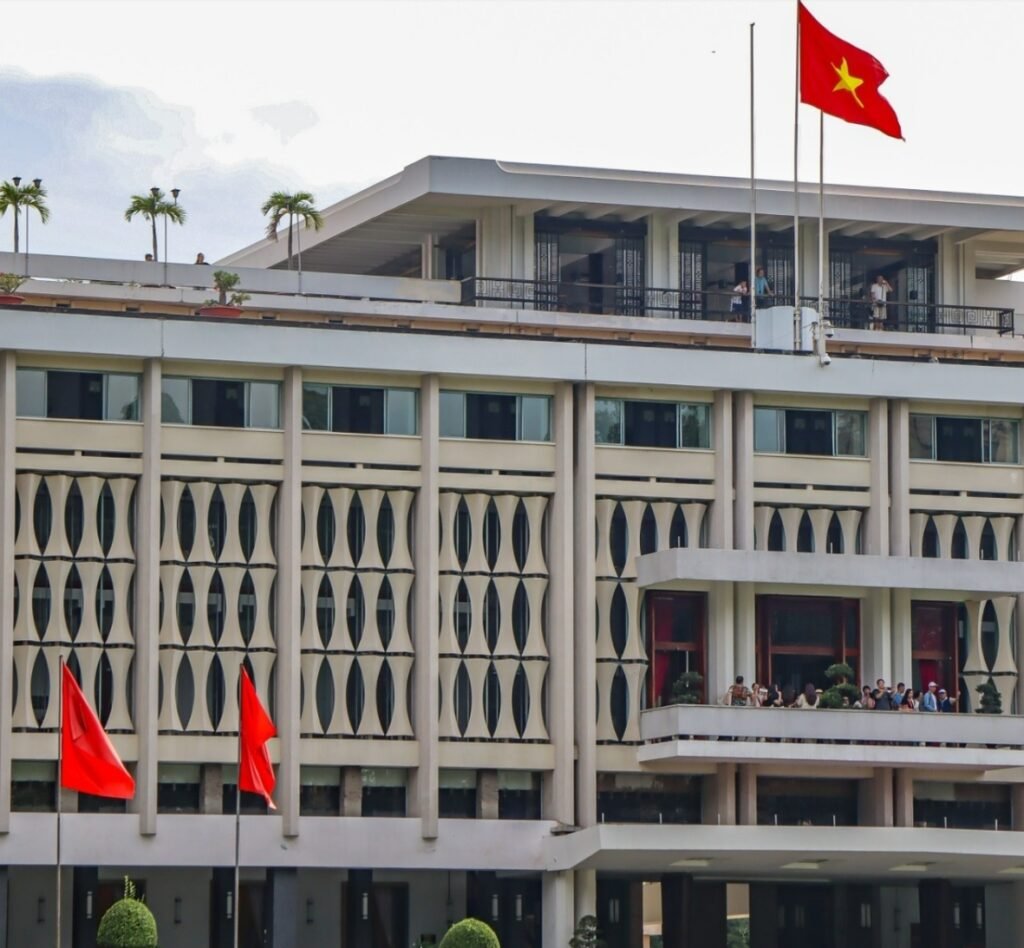
Ho Chi Minh City Hall is a classic Baroque-style building, grand and imposing. In front of it stands a statue of Ho Chi Minh, as if the elder statesman is still quietly watching over the land before him. The blue sky after the rain was incredibly soothing, with a gentle breeze adding to the pleasant atmosphere.


Just a short turn from the square in front of City Hall brings you to the Ho Chi Minh Opera House. While it’s officially called the Ho Chi Minh Opera House, most people prefer to refer to it as the Saigon Opera House. Built in 1898, it features a classic Gothic architectural style. The venue is most famous for the AO Acrobatic Show, with tickets available on KLOOK or at the box office. Unfortunately, due to our schedule, we didn’t get a chance to see it, which I now regret.


Though it’s located in the bustling heart of Ho Chi Minh City, the area around the Opera House still retains a down-to-earth, everyday charm.
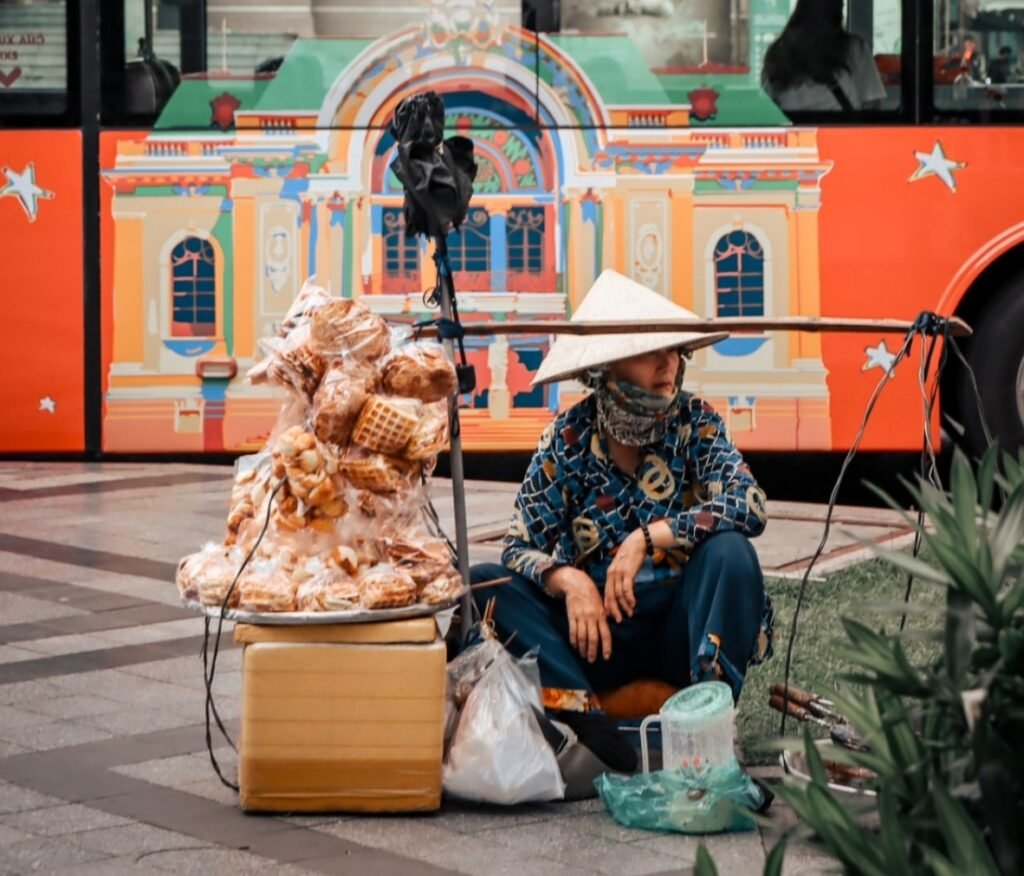

Just a few minutes’ walk straight from the square in front of City Hall, you’ll reach Ho Chi Minh’s famous Coffee Apartment. This building, once a residential apartment, has been transformed into a tourist hotspot, now filled entirely with coffee shops. The name itself hints at how much the Vietnamese love their coffee.
The elevator in the Coffee Apartment requires a fee of VND 3,000 per ride, but if you make a purchase at certain coffee shops, they will refund the elevator fee. It’s recommended to take the elevator to the top floor and then explore the shops one by one as you work your way down.
Since we had other plans today, we only had time to take a quick look at the building’s exterior.

We then took a taxi to a restaurant known as the real-life embodiment of a Hayao Miyazaki anime: Hum, Lounge & Restaurant. Stepping through the doors felt like entering a dreamlike castle from Miyazaki’s world. The serene aesthetics, elegant decor, and beautifully crafted furniture immediately caught our attention.
The space is divided into three levels:
- First Floor: Features a shop selling handmade furniture, essential oils, and home decor items.
- Second Floor: Houses a vegetarian restaurant called Hum.
- Third Floor: Hosts a fusion restaurant called Man Moi, which is where we chose to dine.


This time, we chose the pandan leaf-wrapped chicken, which is one of my favorite dishes at Southeast Asian restaurants. The grilled black pork neck was also delicious, with a fragrant aroma and a nice, bouncy texture. We also had a seafood fried rice, which was fairly standard.
Overall, the food was quite good. You can choose to dine either indoors or outdoors—we sat outdoors and it wasn’t too hot. The prices at this restaurant are a bit higher than most Vietnamese places, and our meal came to around $50. However, it was still reasonable and worth it for the experience.



Tonight’s main event was taking the Ho Chi Minh City sightseeing bus. There are two boarding options: either across from the CHANEL boutique or in front of the LV store (right opposite the Opera House). You can board and disembark at either location. The ticket costs VND 150,000.
The entire ride takes about 45 minutes, and the evening weather was perfect for enjoying the beautiful city lights while feeling the cool breeze on your face. It was a relaxing and comfortable experience, a great way to unwind after a long day. This is definitely something to add to your must-do list in Ho Chi Minh City. If you have time, it’s a great idea to take the bus around sunset, so you can enjoy the transition from day to night and see the sunset and city lights all in one go.


Why visit Vung Tau? As for why I didn’t choose popular tourist cities like Nha Trang, there are a couple of reasons. First, for places like Nha Trang, a same-day round trip isn’t feasible, and moving luggage around can be a hassle. Second, I prefer exploring off-the-beaten-path destinations, so a day trip to Vung Tau naturally became part of my plan.
The most convenient way to get from Ho Chi Minh City to Vung Tau is by bus. We booked our outbound tickets a day in advance on KLOOK, and after booking, the staff contacted us via social media to confirm. For the return trip, I planned to book the tickets the night before departure, but since I was indecisive about the return time, I missed the chance to reserve on KLOOK.
The next day, we took a taxi to the bus company, and once everyone was there, we departed on time. We also purchased our return tickets from Vung Tau to Ho Chi Minh City at the company office, which gave us peace of mind. If it’s not during peak times, you can usually buy tickets on the spot and leave right away. Traveling between Ho Chi Minh City and Vung Tau is very convenient and quick. Midway, the bus stopped at a service station for about 20 minutes. The station was clean and quiet, with restrooms, a restaurant, and a gift shop, offering everything you might need.



After about two hours, we arrived at the Vung Tau bus station, where they switched us to a regular SUV to take us to our destination in the city center.
Our first stop in Vung Tau was Front Beach. The tide hadn’t fully receded yet, but many locals were already enjoying the beach and the small park along the shoreline.


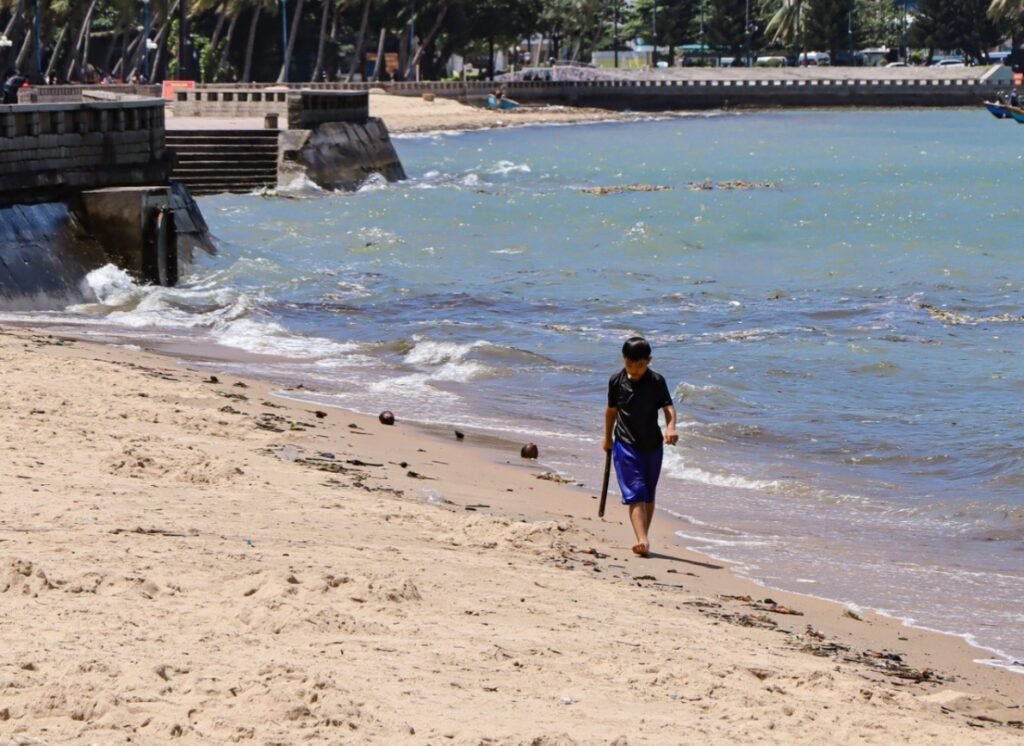



Grandma’s Fruit Smoothies and Juice Rau Má Bà Già is famous for its gotu kola drinks. Yes, it’s the same gotu kola often used in skincare products! I have to say, after arriving in Vietnam, I’ve tried all kinds of strange and interesting herbs.
Most of the drinks here seem to include gotu kola, with variations depending on the fruit or other ingredients added. I ordered the gotu kola with sugarcane drink. I simply showed the owner a picture of it, and whether or not he recognized it, I’m not sure—but the taste was certainly unique, with a refreshingly clean flavor!


Here are a few tips for anyone planning to visit Jesus Mountain:
- You cannot wear shorts or skirts that are above the knee.
- Sun umbrellas are not allowed inside.
- You can’t bring drinks into the area.
There are long pants for sale at the foot of the mountain for VND 50,000 each. However, since it can get quite hot while climbing, you can remove the pants during the hike and put them back on when you reach the Jesus statue at the top.


Behind the Jesus statue is the entrance to climb to the top. Backpacks are not allowed, so you’ll need to carry your valuables like wallets and passports by hand. You’re also required to take off your shoes before entering. Inside, you’ll need to ascend a narrow, steep staircase—so be extra careful as you climb.
At the top, both the left and right shoulders of the statue are accessible, though each side only has space for about two people at a time. Standing on the shoulders of the Jesus statue brought an unexpected wave of emotion, giving real meaning to the phrase “standing on the shoulders of giants.” It was a moment of quiet reflection—travel is not just about moving from place to place. It allows me to see the vastness of the world and, in contrast, my own smallness. Only by seeing the world can one truly shape their worldview.






Back Beach in Vung Tau offers a completely different scene from Front Beach. Arriving in the late afternoon, around 3 or 4 p.m., we found the beach at its liveliest. It was packed with people as far as the eye could see! The coastline of Back Beach is not only much longer than Front Beach, but the crowd was just as large—giving the impression that the entire population of Vung Tau had gathered there.




On the fourth day, we embarked on our day trip to Mui Ne. Initially, I considered booking a tour through a travel website, which costs around $60 per person. However, after further research, I discovered another option: renting a private car for the day.
For the two of us, the round-trip car fare from Ho Chi Minh City to Mui Ne was VND 3,000,000. The half-day Jeep tour in Mui Ne cost VND 600,000, and renting an ATV for the White Sand Dunes was another VND 600,000. In total, the expenses came to VND 4,200,000.
Comparing the costs, it was clear that hiring a private car offered much better value, along with the added flexibility to set our own schedule. If you don’t need to return to Ho Chi Minh City on the same day, participating in just the local half-day tour in Mui Ne would be even more affordable.


The first stop in Mui Ne was a place called Fairy Stream. Despite its name, I personally didn’t see anything particularly “fairy-like” about it. My impression of the place was more like “a pool of footbath water from people all over the world.” It’s essentially a small stream with fine sand at the bottom, where visitors walk through the shallow water to cool off. Tourists of all skin tones waded through the stream with expressionless faces, making the experience feel a bit underwhelming.


The second stop was a small fishing village. As we approached, we were immediately hit by a strong smell of fish. What stood out the most were the distinctive round fishing boats, which are quite unique to this area. However, the visit felt more like a quick photo stop—just enough time to snap a few shots from the roadside before moving on. The parking spot was relatively far from the boats, so you’d need to zoom in quite a bit to get good photos.


The third stop was a photoshoot along the coastal road in the Jeep! This is something not included in the standard group day tours, making the private car option totally worth it. The guide drove us to this stunning stretch of coastal road, and from there, it was all about striking poses and capturing the perfect shots.


The White Sand Dunes are quite expansive, and getting from the parking area to the central area requires an ATV ride. Each ATV can carry two people. While technically not mandatory, given the heat and blowing sand, walking isn’t really an option, so nearly everyone opts for the ATV. The cost of our ATV ride was included in the tour, so there were no additional charges.
On some parts of the route, the driver would race down the dunes, which looked thrilling but didn’t actually give much of a weightless sensation. We tried telling the driver to go “slowly,” but it seemed like he didn’t quite understand. That said, our ride was relatively smooth. We noticed some drivers carrying young Korean tourists, kicking up huge clouds of sand. Even with our tamer ride, by the end of it, we were still covered in sand, from our faces to our mouths.


Looking at this scene, I finally understood the essence of Mui Ne’s charm—“half desert, half sea.” The stark contrast between the endless sand dunes and the shimmering coastline creates a surreal and unforgettable landscape.
On the second day, after returning to Ho Chi Minh City, I visited the Ho Chi Minh City Fine Arts Museum. The building was originally a mansion funded by the prominent Hoa family, led by the wealthy real estate tycoon Hui Bon Hoa. He was said to have owned as many as 20,000 properties.
The mansion, built in the 1920s, features classic Baroque architecture with nearly 100 rooms and even housed the first elevator in Saigon.
Tickets to enter the museum cost 30,000 VND per person and are sold at a small kiosk at the entrance, with ticket checks relying entirely on the honor system.




Ben Thanh Market is a quintessential Southeast Asian bazaar, with rows upon rows of small private stalls crammed into a massive, stadium-like building. In addition to clothing, shoes, and accessories, the market also offers snacks, coffee, and food stalls.
When shopping at Ben Thanh Market, remember one golden rule: bargain hard! Vendors usually negotiate prices using a calculator. Start with a low offer and slowly raise it to increase your chances of success. If the vendor refuses to budge, use the ultimate tactic—turn and walk away! They’ll almost always call you back with a better deal. This trick works every time!

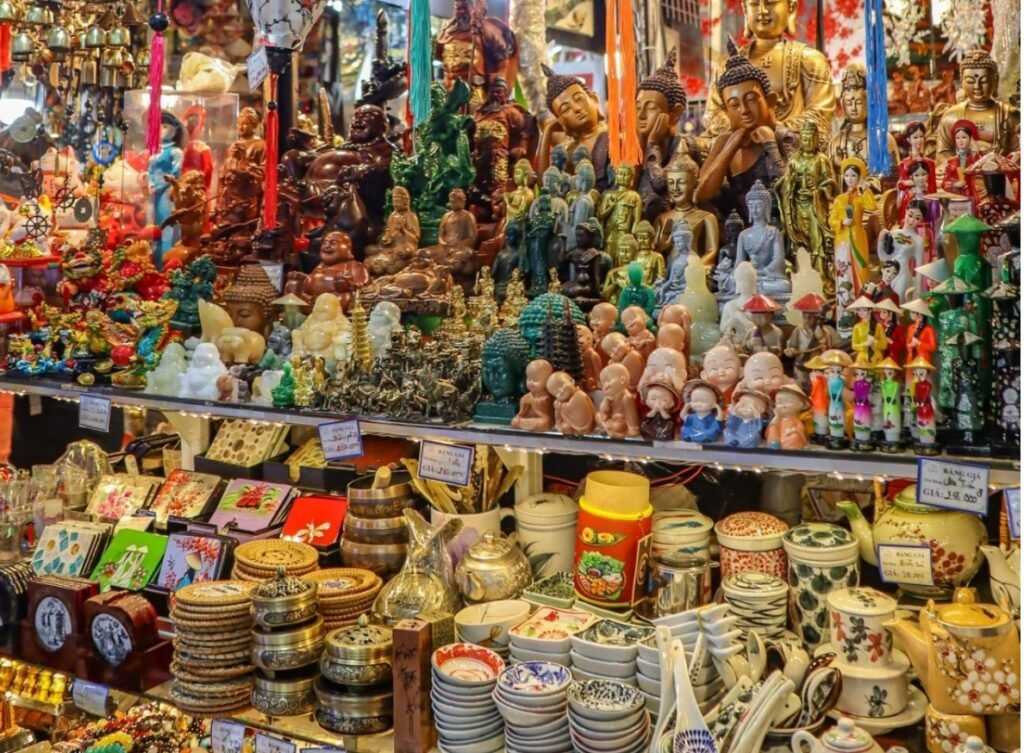
For the best shot of the Pink Church, the recommended spot is the restaurant-bar Ola Hale, located directly across the street. This place is less crowded than the popular Cong Coffee next door and offers more space. Plus, it doesn’t have the black utility poles that obstruct the view from Cong’s balcony.
Ola Hale has great photo spots on the second, third, and fourth floors. Even if you’re not planning to have a full meal, you can still come for afternoon tea—just note that there’s a small table fee for drinks-only orders.




